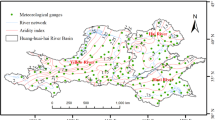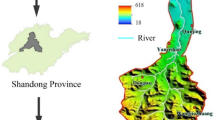Abstract
Based on the climatic data of 580 stations in China during 1956 and 2000, potential evapotranspiration are calculated using the Penman-Monteith Method recommended by FAO. The spatial and temporal distributions of the potential evapotranspiration over China and the temporal trends of the regional means for 10 major river basins and whole China are analyzed. Through a partial correlation analysis, the major climate factors which affect the temporal change of the potential evapotranspiration are analyzed. Major results are drawn as follows: 1) The seasonal and annual potential evapotranspiration for China as a whole and for most basins show decline tendencies during the past 45 years; for the Songhua River Basin there appears a slightly increasing trend. 2) Consequently, the annual potential evapotranspirations averaged over 1980–2000 are lower than those for the first water resources assessment (1956–1979) in most parts of China. Exceptions are found in some areas of Shandong Peninsula, western and middle basins of the rivers in Southwest China, Ningxia Hui Autonomous Region as well as the source regions of the Yangtze and Yellow rivers, which may have brought about disadvantages to the exploration and utilization of water resources. 3) Generally, sunshine duration, wind speed and relative humidity have greater impact on the potential evapotranspiration than temperature. Decline tendencies of sunshine duration and/or wind speed in the same period appear to be the major causes for the negative trend of the potential evapotranspiration in most areas.
Similar content being viewed by others
References
Allen R G, Pereira L S, Raes D et al., 1998. Crop evapotranspiration: guidelines for computing crop water requirements. In: FAO Irrigation & Drainage Paper 56. FAO, ISBN 92-5-104219-5.
Chen D, G Gao, C Y Xu et al., 2005. Comparison of Thornthwaite method and pan data with the standard Penman-Monteith estimates of potential evapotranspiration for China. Climate Research, 28: 123–132.
Doorenbos J, Pruitt W O, 1977. Guidelines for predicting crop water requirements. Food and Organization United Nations, FAO Irrigation and Drainage Paper 24, 2nd edn. Rome.
Feng Zhiming, Yang Yanzhao, Ding Xiaoqiang et al., 2004. Temporal-spatial changing characteristics of reference crop evapotranspiration in Gansu Province. Transactions of the Chinese Society of Agricultural Engineering, 20(1): 99–103. (in Chinese)
Guo Jianping, Gao Suhua, Mao Fei, 2001. Study on drought tendency and defending countermeasures in north part of China. Journal of Natural Disasters, 10(3): 32–36. (in Chinese)
Guo Jun, Ren Guoyu, 2005. Recent change of pan evaporation and the possible climate factors over the Huang-Huai-Hai Watersheds. Advance in Water Science, 16(5): 666–672. (in Chinese)
Jensen M E, Burman R D, Allen R G, 1990. Evapotranspiration and irrigation water requirements. In: ASCE Manuals and Reports on Engineering Practice, No.70, 332.
Li Xiaowen, Li Weiliang, Zhou Xiuji, 1998. Analysis of the solar radiation variation of China in recent 30 years. Quarterly Journal of Applied Meteorology, 9(1): 24–31. ( in Chinese)
Li Yulin, Cui Jianyuan, Zhang Tonghui, 2002. Comparative study on calculation methods of potential evapotranspiration. Journal of Desert Research, 22(4): 372–376. (in Chinese)
Li Lin, Zhang Guosheng, Wang Qingchun et al., 2000. Study on evapotranspiration and its impact factors over Yellow River upper stream area. Advance in Earth Sciences, 15(3): 256–259. (in Chinese)
Linacre E T, 2004. Evaporation trends. Theoretical and Applied Climatology, 79: 11–21.
Liu Binhui, Xu Ming, Mark Henderson et al., 2004. A spatial analysis of pan evaporation trends in China, 1955–2000. Journal of Geophysical Research, 109, D15102. doi:10.1029 /2004JD004511:1–9.
Liu Shaomin, Sun Zhongping, Li Xiaowen et al., 2003. A comparative study on models for estimating evapotranspiration. Journal of Natural Resources, 18(2): 161–167. (in Chinese)
Ma Zhuguo, Hua Lijuan, Ren Xiaobo, 2003. The extreme dry/wet events in northern China during recent 100 years. Acta Geographica Sinica, 58(suppl.): 69–74. (in Chinese)
Peterson T C, Golubev V S, Groisman P Y, 1995. Evaporation losing its strength. Nature, 377: 687–688.
Preliminarily Assessment to China Water Resources, 1981. The technique group to ensemble the preliminary achievements of China first water resources assessment. The Water Resources Study Office of Ministry of Water Resources of the People’s Republic of China, 48-51. (in Chinese)
Qian W H, D Chen, Q Lin et al., 2004. Regional temperature and precipitation trend under global change. Newsletter for Climate Change, 3(3): 8–9. (in Chinese)
Qiu Xinfa, Liu Changming, Zeng Yan, 2003. Changes of pan evaporation in recent 40 years over the Yellow River Basin. Journal of Natural Resources, 18(4): 437–442. (in Chinese)
Ren Guoyu, Guo Jun, 2006. Change in pan evaporation and the influential factors over China: 1956–2000. Journal of Natural Resources, 21(1): 31–44. (in Chinese)
Roderick M L, Farquhar G D, 2002. The cause of decreased pan evaporation over the past 50 years. Science, 298(15): 1410–1411.
Thomas A, 2000. Spatial and temporal characteristics of potential evapotranspiration trends over China. International Journal of Climatology, 20: 381–396.
Wang Zunya, Ding Yihui, He Jinhai et al., 2004. An updating analysis of the climate change in China in recent 50 years. Acta Meteorologica Sinica, 62(2): 228–236. (in Chinese)
Wei Fengying, Cao Hongxing, Wang Liping, 2003. Climatic warming process during 1980s–1990s in China. Journal of Applied Meteorological Science, 14(1): 79–86. (in Chinese)
Xu C Y, D Chen, 2005. Comparison of seven models for estimation of evapotranspiration and groundwater recharge using lysimeter measurement data in Germany. Hydrological Processes, 19: 3717–3734.
Xu C Y, L Gong, T Jiang et al., 2006. Analysis of spatial distribution and temporal trend of reference evapotranspiration in Changjiang catchment. J. Hydrology. (in press)
Yang Jianping, Ding Yongjian, Chen Rensheng et al., 2002. The interdecadal fluctuation of dry and wet climate boundaries in China in recent 50 years. Acta Geographica Sinica, 57(6): 655–661. (in Chinese)
Yang Jianping, Ding Yongjian, Chen Rensheng et al., 2003. Variations of precipitation and evaporation in North China in recent 40 years. Journal of Arid Land Resources and Environment, 17(2): 6–11. (in Chinese)
Zhou Xiaodong, Zhu Qijiang, Sun Zhongping et al., 2002. Preliminary study on regionalization desertification climate in China. Journal of Natural Disasters, 11(2): 125–131. (in Chinese)
Zhu Changhan, 1982. A further discussion on the climatological calculating method of total radiation (II). Journal of Nanjing Institute of Meteorology, (2): 196–206. (in Chinese)
Author information
Authors and Affiliations
Additional information
Foundation: Chinese Ministry of Water Resources: Special Study to Water Resources Comprehensive Planning of China; Ministry of Science and Technology of China, No.2001BA611B, Sida and STINT
Rights and permissions
About this article
Cite this article
Gao, G., Chen, D., Ren, G. et al. Spatial and temporal variations and controlling factors of potential evapotranspiration in China: 1956–2000. J GEOGR SCI 16, 3–12 (2006). https://doi.org/10.1007/s11442-006-0101-7
Received:
Accepted:
Issue Date:
DOI: https://doi.org/10.1007/s11442-006-0101-7




